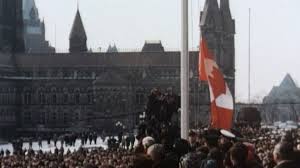Februrary 15, 1965, was the day I reported for work as a reporter on Parliament Hill. It happened to be the day that the new Canadian Maple Leaf flag flew for the first time. I recalled those times in my 2018 book, “Power, Prime Ministers and the Press,” Dundurn. It was not all sweetness and light. Excerpt:

Prologue
NEW BOY ON THE HILL
The day I arrived for work in the Parliamentary Press Gallery, February 15, 1965, was a grand occasion. It was not about me, an unknown, fresh-faced twenty-two-year-old reporter, who had landed at the train station the day before with all my worldly possessions in a green steamer trunk. The excitement was about the new Canadian flag snapping in the clear, chill air atop the Gothic Revival Peace Tower, the stylized eleven-point red maple leaf proclaiming a new day. It went up for the first time amid prayers and much hope. Prime Minister Lester Pearson, who had led the divisive battle to replace the Red Ensign as Canada’s national flag, intoned: “God bless our flag, and God bless Canada.” Governor General Georges Vanier told a cheering crowd of ten thousand: “I appeal to all Canadians to set aside pettiness, selfishness, and intolerance where they may exist, and to cultivate a spirit of brotherhood and mutual confidence.”
What I witnessed unfolding inside the building over the remaining months of the twenty-sixth Parliament — and beyond — gave new meaning to the words pettiness, selfishness, and intolerance. For me, it was a rude awakening. From one day to the next, crisis gave way to chaos. Personal name-calling and allegations of scandal reverberated through the halls, whether it was a federal worker accused of being a Russian spy or a mysterious East German woman admitting she had a relationship with a Cabinet minister. Someone set off a bomb in the washroom adjacent to the prime minister’s office, killing himself but no one else. Aides to the prime minister were accused of consorting with the Mafia, and one went to jail for accepting a bribe. Cabinet ministers left in disgrace, seemingly almost as fast as they arrived. The many judicial commissions of inquiry became a growth industry for lawyers and consultants. Even from a distance of fifty years, it was truly one of the most bitter periods in Canadian parliamentary history, embracing the bloody downfall of Progressive Conservative leader John Diefenbaker, scandals and allegations that tainted the reputations of Cabinet ministers on both sides of the House, and the unhappy end of Lester Pearson’s political career. It also got me on page 1 most days.
It was truly a wonderful time for a journalist to claim a front-row seat to watch Canadian history unfold, with all its imperfections — and in all its glory. Indeed, amid the many crises — manufactured and real — came some lasting legislation that endures today: the Canada Pension Plan, medicare, reform of immigration rules, the Canada Assistance Plan, and the Pearsonian concept of official bilingualism. And throughout, there was the leitmotif of Canada’s past and present, the ebb and flow of nationalism in Quebec, and the federation’s struggle to respond.
“Power, Prime Ministers and the Press,” Dundurn, 2018



0 Comments